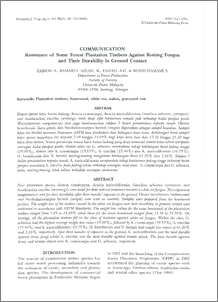Citation
Ashaari, Zaidon and Mohd Nasir, Kamarul Azlan and Abood Haris, Faizah and Sahri, Mohd Hamami
(2002)
Resistance of some forest plantation timbers against rotting fungus and their durability in ground contact.
Pertanika Journal of Tropical Agricultural Science, 25 (1).
pp. 69-73.
ISSN 1511-3701
Abstract
Four plantation species, Acacia crassicarpa, Acacia auriculiformis, Gmelina arborea (yemane) and Azadirachta excelsa (sentang)) were tested far their natural resistance towards a white rotfungus (Pycnoporous sanguineus) and for their durability after three months' exposure to the ground. Hevea brasiliensis (rubberwood) and Neobalanocarpus heimii (cengal) were used as controls. Samples were prepared from the heartwood portion. The weight loss of the timbers caused by the white rot fungus and their durability in ground contact were evaluated in accardance with ASTM Standards. The weight loss values far the outer heartwood of the plantation timbers ranged from 7.69 to 14.69% while those far the inner heartwood ranged from 13.16 to 24.20%. On average, all the plantation timbers fell in the class of resistant against white rot fungus. Within the class, G.
arborea had the highest average weight loss value (19.88%), followed by A. crassicarpa (19.53%), A. excelsa (15.44%) andA. auriculiformis (10.75%). H. brasiliensis and N. heimii had weight loss values of61.20% and 2.16%, respectively. After three months of exposure in the ground, A. auriculiformis was the most durable against decay fungi whilst A. excelsa was the most durable against termite attack. The least durable against decay and termite attack were A crassicarpa and G. arborea, respectively.
Download File
![[img]](http://psasir.upm.edu.my/style/images/fileicons/application_pdf.png)  Preview |
|
PDF
Resistance_of_Some_Forest_Plantation_Timbers_Against_Rotting_Fungus.pdf
Download (3MB)
|
|
Additional Metadata
Actions (login required)
 |
View Item |

